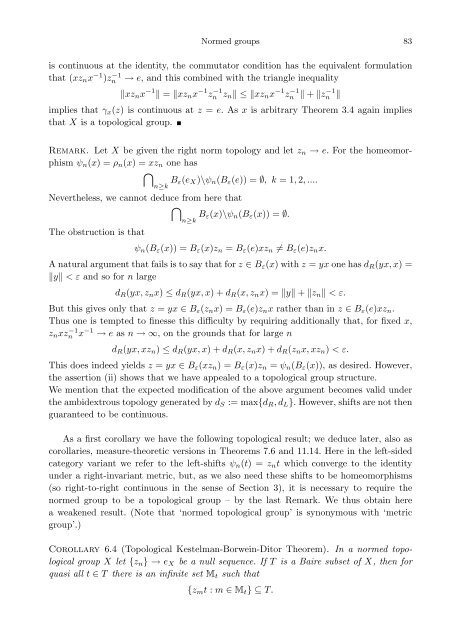Normed versus topological groups: Dichotomy and duality
Normed versus topological groups: Dichotomy and duality
Normed versus topological groups: Dichotomy and duality
Create successful ePaper yourself
Turn your PDF publications into a flip-book with our unique Google optimized e-Paper software.
<strong>Normed</strong> <strong>groups</strong> 83is continuous at the identity, the commutator condition has the equivalent formulationthat (xz n x −1 )zn−1 → e, <strong>and</strong> this combined with the triangle inequality‖xz n x −1 ‖ = ‖xz n x −1 z −1nz n ‖ ≤ ‖xz n x −1 z −1n‖ + ‖zn−1 ‖implies that γ x (z) is continuous at z = e. As x is arbitrary Theorem 3.4 again impliesthat X is a <strong>topological</strong> group.Remark. Let X be given the right norm topology <strong>and</strong> let z n → e. For the homeomorphismψ n (x) = ρ n (x) = xz n one has⋂n≥k B ε(e X )\ψ n (B ε (e)) = ∅, k = 1, 2, ....Nevertheless, we cannot deduce from here that⋂n≥k B ε(x)\ψ n (B ε (x)) = ∅.The obstruction is thatψ n (B ε (x)) = B ε (x)z n = B ε (e)xz n ≠ B ε (e)z n x.A natural argument that fails is to say that for z ∈ B ε (x) with z = yx one has d R (yx, x) =‖y‖ < ε <strong>and</strong> so for n larged R (yx, z n x) ≤ d R (yx, x) + d R (x, z n x) = ‖y‖ + ‖z n ‖ < ε.But this gives only that z = yx ∈ B ε (z n x) = B ε (e)z n x rather than in z ∈ B ε (e)xz n .Thus one is tempted to finesse this difficulty by requiring additionally that, for fixed x,z n xzn−1 x −1 → e as n → ∞, on the grounds that for large nd R (yx, xz n ) ≤ d R (yx, x) + d R (x, z n x) + d R (z n x, xz n ) < ε.This does indeed yields z = yx ∈ B ε (xz n ) = B ε (x)z n = ψ n (B ε (x)), as desired. However,the assertion (ii) shows that we have appealed to a <strong>topological</strong> group structure.We mention that the expected modification of the above argument becomes valid underthe ambidextrous topology generated by d S := max{d R , d L }. However, shifts are not thenguaranteed to be continuous.As a first corollary we have the following <strong>topological</strong> result; we deduce later, also ascorollaries, measure-theoretic versions in Theorems 7.6 <strong>and</strong> 11.14. Here in the left-sidedcategory variant we refer to the left-shifts ψ n (t) = z n t which converge to the identityunder a right-invariant metric, but, as we also need these shifts to be homeomorphisms(so right-to-right continuous in the sense of Section 3), it is necessary to require thenormed group to be a <strong>topological</strong> group – by the last Remark. We thus obtain herea weakened result. (Note that ‘normed <strong>topological</strong> group’ is synonymous with ‘metricgroup’.)Corollary 6.4 (Topological Kestelman-Borwein-Ditor Theorem). In a normed <strong>topological</strong>group X let {z n } → e X be a null sequence. If T is a Baire subset of X, then forquasi all t ∈ T there is an infinite set M t such that{z m t : m ∈ M t } ⊆ T.
















